This is an excerpt from “E(race)ing Inequities: The State of Racial Equity in North Carolina Public Schools” by the Center for Racial Equity in Education (CREED). Go here to read the full report and to find all content related to the report, including the companion report Deep Rooted.
Decades of research has found that students of color are disciplined more often and more harshly than their White counterparts, often for the same infractions, even after controlling for other relevant factors, such as (mis)behavior rates and socioeconomic status (Children’s Defense Fund, 1975; Skiba et al., 2014). Concurrent scholarship has demonstrated repeatedly that different racial/ethnic groups have similar misbehavior rates (Finn, Fish, & Scott, 2008; McCarthy & Hoge, 1987; Gregory & Weinstein, 2008). When racial/ethnic differences in (mis)behavior have been detected, those differences have been insufficient to explain the magnitude of racial/ethnic discipline disparities (Eitle & Eitle, 2004; Peguero & Shekarkhar, 2011; Skiba & Williams, 2014; Wallace, Goodkind, Wallace, & Bachman, 2008). Racialized patterns of school discipline have been found to contribute to disproportionate losses in instructional time, diminished academic achievement, school dropout, social and emotional harm, and increased interactions with criminal and juvenile justice systems (Fabelo et al., 2011; Wallace et al., 2008). Furthermore, studies have shown that racial/ethnic disparities in school discipline are larger in subjective offense categories (i.e. disruption, disobedience, insubordination) as opposed to more objectively defined behaviors (i.e. fighting, drugs, alcohol, weapons) (Gregory, Bell & Pollock, 2014; Skiba, Michael, Nardo & Peterson, 2002).
The rate of suspension nationally has increased dramatically since the 1980s (Losen & Martinez, 2013; Skiba 2000). Only recently have schools and districts begun to acknowledge the harmful and inequitable application of punitive discipline and to turn to less punitive policies and practices (U.S. Department of Education, 2014). However, this report documents the continued widespread use of suspension in North Carolina schools as well as persistent racial/ethnic disparities in the application of school discipline.
School discipline is a complex phenomenon influenced by multiple, interrelated factors such as federal/state/district discipline policies, school culture and behavioral norms, administrators’ beliefs, teachers’ dispositions, classroom dynamics, student traits and behaviors, etc. While we recognize that discipline outcomes are often contingent upon the actions and decisions of individual school-based actors (i.e. students, teachers, principals), we analyzed aggregated statewide school discipline patterns to assess whether students with different racial/ethnic backgrounds had different levels of exposure to the harmful effects of exclusionary discipline. Therefore, in the context of this report, we position school discipline primarily as an indicator of students’ access and opportunity to fully participate in North Carolina public schools.
North Carolina collects data on all office referrals given in the state. We analyzed all instances of in-school suspension1 (ISS) and out of school suspension (OSS) reported to the North Carolina Department of Public Instruction for the 2016-2017 school year. We report the statewide incidence of ISS and OSS and the racial/ethnic demographics of students who were suspended. We also assess whether race/ethnicity is a significant predictor of suspension and whether any detected effect of race/ethnicity remains significant after controlling for gender, free/reduced lunch eligibility, language status, special education status, and giftedness. Because some students were suspended more than once over the school year, we report results on all incidences of suspension and all students suspended at least once separately.
Methodology
In 2016-2017, approximately 260,000 office referrals resulted in in-school suspension (ISS) and approximately 235,000 resulted in out-of-school suspension (OSS). The proportion of all incidences of suspension for each racial/ethnic student group and the proportion of all North Carolina students represented by each racial group are reported in Figure 7.1.
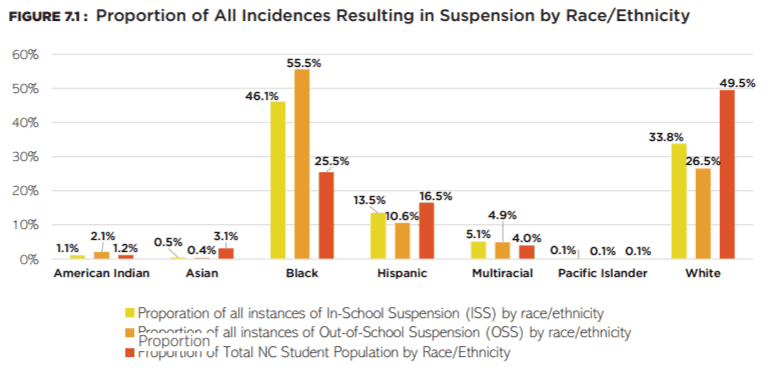
Analysis
American Indian, Asian, Hispanic, and White students are under-selected for ISS, Pacific Islanders are proportionately selected, and Black and Multiracial students are over-selected. For OSS, Asian, Hispanic, and White students were under-selected, Pacific Islanders are proportionately selected, and American Indian, Black, and Multiracial students are over-selected. The magnitude of disparity between Black students and those from other racial/ethnic groups in both ISS and OSS is particularly noteworthy.
Figure 7.2 presents the proportion of each racial/ethnic student group that received ISS and OSS at least once in 2016-17.
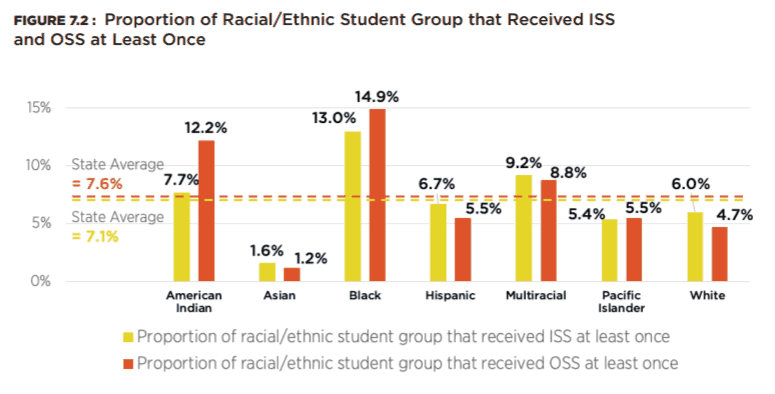
Black students (14.9%) received out-of-school suspensions at least once at almost twice the state average of 7.6%. American Indian (12.2.%) and Multiracial (8.8%) also had rates substantially above the state average. Asian, Hispanic, Pacific Islander, and White students received OSS at least once at rates well below the state average.
To give a sense of the magnitude of the racial discipline gap in the state, if Black students had been given OSS at least once at the state average rate, almost 30,000 fewer Black students would have experienced OSS during the 2016-2017 school year. The average length of OSS for Black students was 1.94 days. Thus, those 30,000 fewer suspensions translate into approximately 58,000 fewer days suspended out of school for Black students.
As we observed with OSS, Black students (13.0%) received in-school suspension at least once at almost twice the state average (7.1%). ISS rates for American Indian (7.7%) and Multiracial (9.2%) students also exceeded the state average. The remaining racial/ethnic groups received ISS at rates below the state average, with Asian ISS rate (1.6%) coming in at less than a quarter of the state average.
In comparing the in-school and out-of-school suspension rates for students from different racial/ethnic groups, we see that, relative to other groups, American Indian and Black students have higher rates for out-of-school suspension than in-school suspension. Given that students remain in school and remain supervised by school staff, we view ISS as a less punitive form of punishment. To the extent that NC conforms to substantial literature suggesting little difference in misbehavior rates among racial/ethnic groups, this may further suggest that American Indian, Black, and potentially Multiracial students are targeted for more punitive discipline (OSS) while less punitive forms of discipline (ISS) are rationed for other racial/ethnic groups (Payne & Welch, 2010; Welch & Payne, 2010).
We also compared the length of suspension as a factor of race/ethnicity by comparing the proportion of ISS and OSS incidents to the proportion of ISS and OSS days served within each racial/ethnic group. The proportion of days served was similar or smaller than the proportion of suspension incidents for all groups except Black students. For both ISS and OSS, Black students represented a higher proportion of the total days served then they did the total incidents. This suggests that in addition to being the group with the highest discipline rates, Black students also tend to be given longer suspensions than all other groups.
The results in Figures 7.1 and 7.2 largely mirror the existence and magnitude of suspension disparities found in the literature over the last five decades (Triplett, 2018). While the tables above clearly demonstrate numerical disparities in suspension between racial/ethnic groups, discipline outcomes are influenced by a number of factors. For instance, males have much higher suspension rates than females regardless of race/ethnicity or school context. Males also have substantially higher misbehavior rates (Finn et al., 2008). Students in poverty, non-native English speakers, and students labeled as disabled traditionally have higher rates of suspension as well. Therefore, it is plausible (though unlikely) that the differences in suspension rates for racial/ethnic groups shown in Figures 7.1 and 7.2 might be explained by differences in other factors like gender, socioeconomic status, language status, and special education status.
Prediction Models
In order to isolate the effect of race/ethnicity to the greatest extent possible given the available data, we created statistical models predicting the likelihood of a student being suspended at least once based on race/ethnicity as compared to White students, while controlling for the effect of gender, free/reduced lunch eligibility, language status, special education status, and giftedness. In both the ISS and OSS models, race/ethnicity was a significant and substantial predictor of being suspended after controlling for other factors.
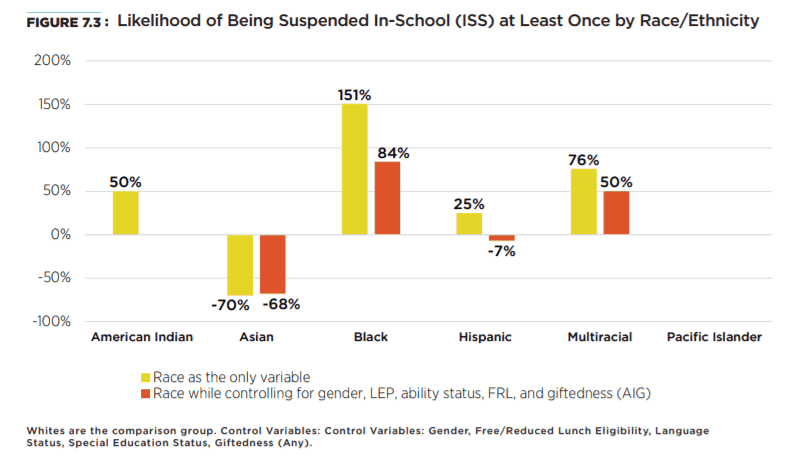
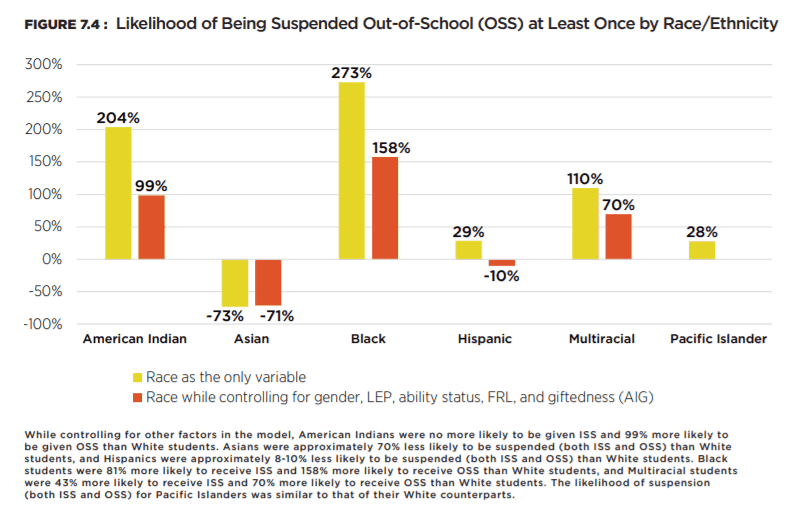
While controlling for other factors in the model, American Indians were no more likely to be given ISS and 99% more likely to be given OSS than White students. Asians were approximately 70% less likely to be suspended (both ISS and OSS) than White students, and Hispanics were approximately 8% less likely to be suspended (both ISS and OSS) than White students. Black students were 84% more likely to receive ISS and 158% more likely to receive OSS than White students, and Multiracial students were 50% more likely to receive ISS and 70% more likely to receive OSS than White students. The likelihood of suspension (both ISS and OSS) for Pacific Islanders was similar to that of their White counterparts.
As a final test of the ways that race/ethnicity might influence discipline outcomes, we split the offense descriptions provided by schools into subjective and objective offenses. Recall that racial/ethnic disparities in school discipline tend to be larger in subjective offense categories as opposed to more objectively defined behaviors (Gregory, Bell & Pollock, 2014; Skiba, Michael, Nardo & Peterson, 2002). Traditional school discipline offenses such as fighting, smoking, drug violations, and weapons violations were labelled objective. Offenses that are more open to interpretation, such as disobedience, insubordination, disrespect, and disruption, were labelled as subjective offenses.2 We then calculated the number of incidents resulting in suspension (ISS or OSS) that involved subjective offenses. Table 7.1 presents the results.
Black students were suspended for incidents involving subjective offenses at the highest rate (51%), followed by Multiracial students (50%), American Indian students (46%), Whites (46%), Pacific Islanders (45%), Hispanics (42%), and Asians (30%).
If Black students had been suspended for incidents involving subjective offenses at the average rate for all students, it would represent approximately 8000 fewer suspensions.
Given that these figures align well with differences in overall suspension rates, the data suggest that the interpretation of student behavior by school authorities may contribute to racial/ethnic discipline disparities in the state, particularly for American Indian, Black, and Multiracial students.
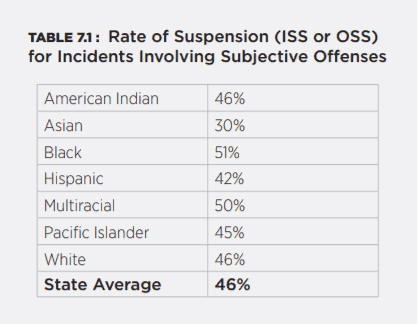
Takeaways
The findings of this report are remarkably similar to the collected findings of discipline research since the 1970s. It is worth reiterating that research using large, nationally representative samples have repeatedly found little to no difference in (mis)behavior rates between racial/ethnic groups (Finn et al., 2008; Skiba & Williams, 2014). To the extent that North Carolina conforms to this finding, the results of this report suggest that American Indian, Black, and Multiracial students are disproportionately exposed to the negative effects of school discipline. Not only are American Indian, Black, and Multiracial students over-represented generally in the incidence of both in-school and out-of-school suspensions, they appear to be the disproportionate recipients of suspensions involving subjective offenses and receive harsher forms of discipline (OSS vs. ISS) at higher rates. Furthermore, Black students receive longer suspensions on average than any other student group.
Our results for Black students are highly disturbing given that almost 50 years of documented discipline disparities appear to have done nothing to reduce the over-selection of Black students for school discipline. As such, the magnitude and persistence of the discipline gap and the harm accumulated by Black, American Indian, and most likely, Multiracial students in terms of lost instructional time, achievement, graduation rates, and social/emotional well-being provides a powerful lens through which to understand racial/ethnic gaps in other educational outcomes.
Suspension also provides a powerful conceptual example of how educational stakeholders can begin to understand racial differences in educational achievement and attainment as a factor of differential access to full participation in school. While the data do not allow us to make causal claims about the relationship between discipline and achievement/attainment, one can easily trace a conceptual path from racial disparities in discipline to less time in school to lower grades and higher dropout rates.
The suggestion that discipline outcomes influence academic outcomes is borne out elsewhere in this report. Our analysis of high school dropout data indicates that while controlling for other factors, including race/ethnicity, students that were suspended at least once during the year they dropped out were 230% more likely to drop out than those not suspended.
In addition, in depth analysis of EOC/EOG scores showed that having been suspended at least once was a powerful predictor of a lower mean scale score and lower achievement level across a sample of assessments, including 8th grade math, 8th grade reading, Math I, English II, and Biology. On all assessments tested, suspended students scored roughly five points lower than students who were not suspended. In all cases, a single suspension had a stronger negative effect on EOC/EOG scores than free/reduced lunch status.
It is worth reiterating here that unless North Carolina represents some kind of aberration in the area of race/ethnicity and student behavior, it is reasonable to assume that students from different racial groups in the state have minimal, if any, differences in misbehavior rates based on the strength of past literature on the subject.
The only studies that have successfully reduced students’ race/ethnicity to statistical non-significance have included metrics related to school climate and the disciplinary dispositions of school administrators (Skiba, R. J., Chung, C. G., Trachok, M., Baker, T. L., Sheya, A., & Hughes, R. L.; 2014). Therefore, it is likely that to fully account for the effect of race/ethnicity on student discipline outcomes, North Carolina will need to begin collecting more robust data on school climate, school authorities, and their relationship to racial discipline gaps.
References
Eitle, T. M. N., & Eitle, D. J. (2004). Inequality, segregation, and the overrepresentation of African Americans in school suspensions. Sociological Perspectives, 47, 269-287.
Fabelo, T., Thompson, M. D., Plotkin, M. D., Carmichael, D., Marchbanks, M. P., & Booth, E. A. (2011). Breaking schools’ rules: A statewide study of how school discipline relates to students’ success and juvenile justice involvement. New York, NY: Council of State Governments Justice Center.
Finn, J. D., Fish, R. M., & Scott, L. A. (2008). Educational sequelae of high school misbehavior. The Journal of Educational Research, 101(5), 259-274.
Gregory, A., Bell, J., & Pollock, M. (2014). How educators can eradicate disparities in school discipline: A briefing paper on school-based interventions. South Bend, IN: The Equity Project at Indiana University, Center for Evaluation and Education Policy.
Gregory, A., & Weinstein, R. S. (2008). The discipline gap and African Americans: Defiance or cooperation in the high school classroom. Journal of School Psychology, 46(4), 455-475
McCarthy, J. D., & Hoge, D. R. (1987). The social construction of school punishment: Racial disadvantage out of universalistic process. Social Forces, 65, 1101-1120.
Payne, A. A., & Welch, K. (2010). Modeling the effects of racial threat on punitive and restorative school discipline practices. Criminology, 48(4), 1019-1062.
Peguero, A. A., & Shekarkhar, Z. (2011). Latino/a student misbehavior and school punishment. Hispanic Journal of Behavioral Sciences, 33(1), 54-70.
Skiba, R. J., Chung, C. G., Trachok, M., Baker, T. L., Sheya, A., & Hughes, R. L. (2014). Parsing disciplinary disproportionality: Contributions of infraction, student, and school characteristics to out-of-school suspension and expulsion. American Educational Research Journal, 51(4), 640-670.
Skiba, R. J., Horner, R. H., Chung, C.-G., Rausch, M. K., May, S. L., & Tobin, T. (2011). Race is not neutral: A national investigation of African American and Latino disproportionality in school discipline. School Psychology Review, 40(1), 85-107.
Skiba, R. J., Michael, R. S., Nardo, A. C., & Peterson, R. (2002). The color of discipline: Sources of racial and gender disproportionality in school punishment. Urban Review, 34(4), 317–342.
Skiba, R. J., & Williams, N. T. (2014). Are Black kids worse? Myths and facts about racial differences in behavior. The Equity Project at Indiana University.
Wallace, J. M. Jr., Goodkind, S., Wallace, C. M., & Bachman, J. G. (2008). Racial, ethnic, and gender differences in school discipline among U. S. high school students: 1991-2005. Negro Educational Review, 59(1-2), 47-62.
Welch, K. & Payne, A. A. (2010). Racial threat and punitive school discipline. Social Problems, 57(1), 25-48.
Editor’s note: James Ford is on contract with the N.C. Center for Public Policy Research from 2017-2020 while he leads this statewide study of equity in our schools. Center staff is supporting Ford’s leadership of the study, conducted an independent verification of the data, and edited the reports.



